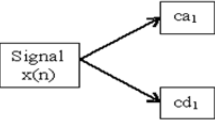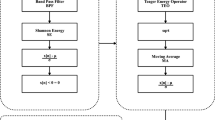Abstract
The electrocardiogram is an important tool that is widely used for diagnosis of many cardiovascular diseases. In this context, QRS complex detection is a very crucial step in the ECG diagnosis system. The major aim of this work is to develop a novel method for QRS complex detection under various ECG signal morphologies as well as under different ECG recording conditions, including numerous noise sources and varying QRS waveforms. The proposed algorithm is based principally on the stationary wavelet transform (SWT) and Teager energy operator (TEO). In our scheme, SWT is first used for ECG signal preprocessing and QRS complex frequency content localization. Subsequently, a novel process for R peak detection based on TEO and a moving average (MA) filter is introduced. More precisely, SWT is coupled with TEO and the MA filter to construct a smoothed detection mask. Then, after the mask segmentation and adaptive thresholding steps, R peak times are identified using the maxima detected on the created mask and employing a reference ECG signal. At this stage, efficient decision rules are applied for reducing the number of false alarms. In the experiments, we validate the proposed method on the well-known annotated MIT-BIH arrhythmia database (MITDB). The experimental results show that the newly proposed algorithm provides satisfactory detection performances compared to the recent state-of-the-art methods, with an average sensitivity of 99.84%, average positive predictivity (P+) of \(99.87\%\), detection error rate of 0.30% and an overall detection accuracy of 99.70%. Also, the proposed method presents a low computational time complexity with an average processing time of 12 s on each ECG record from MITDB.














Similar content being viewed by others
Notes
This fact makes a time varying mask segmentation process.
Based on our a priori knowledge about MITDB, the minimum time interval between two consecutive correctly annotated beats is exactly equal to 250 ms. This constraint has a physiological point of view that two heartbeats cannot physiologically happen in less than 250 ms [38].
References
P.S. Addison, Wavelet transforms and the ECG : a review. Phys. Meas. 5(26), 155–199 (2005). https://doi.org/10.1088/0967-3334/26/5/R01
V. Afonso, W. Tompkins, T. Nquyen, S. Luo, ECG beat detection using filter banks. IEEE Trans. Biomed. Eng. 46(2), 192–201 (1999)
A. Antoniadis, Wavelet methods in statistics: Some recent developments and their applications. Stat. Surv. 1, 16–55 (2007)
Association for the Advancement of Medical Instrumentation: Testing and reporting performance results of cardiac rhythm and ST segment measurement algorithms. ANSI/AAMI EC57 (1998)
S. Banerjee, R. Gupta, M. Mitra, Delineation of ECG characteristic features using multiresolution wavelet analysis method. Measurement 45(3), 474–487 (2012). https://doi.org/10.1016/j.measurement.2011.10.025
S. Benitez, P. Gaydecki, A. Zaidi, A. Fitzpatrick, The use of the Hilbert transform in ECG signal analysis. Comput. Biol. Med. 31, 399–406 (2001)
F. Bouaziz, D. Boutana, M. Benidir, Multiresolution wavelet-based QRS complex detection algorithm suited to several abnormal morphologies. IET. Signal. Process. 8(7), 774–782 (2014). https://doi.org/10.1049/iet-spr.2013.0391
E.L. Bouny, L.M. Khalil, A. Adib, ECG signal filtering based on CEEMDAN with hybrid interval thresholding and higher order statistics to select relevant modes. Multimed. Tools. Appl. 78, 13067–13089 (2019). https://doi.org/10.1007/s11042-018-6143-x
R.J. Brychta, S. Tuntrakool, M. Appalsamy, N.R. Keller, D. Robertson, R.G. Shiavi, A. Diedrich, Wavelet methods for spike detection in mouse renal sympathetic nerve activity. IEEE Trans. Biomed. Eng. 54(1), 82–93 (2007)
S. Chen, H. Chen, H. Chan, A real-time QRS method based on moving-averaging incorporating with wavelet denoising. Comput. Methods Prog. Biomed. 82(3), 187–195 (2006)
J.H. Choi, H.K. Jung, T. Kim, A new action potential detector using the mteo and its effects on spike sorting systems at low signal-to-noise ratios. IEEE Trans. Biomed. Eng. 53(4), 738–746 (2006)
G.D. Clifford, F. Azuaje, P.E. McSharry, Advanced methods and tools for ECG data analysis, in Artech House Engineering in Medicine and Biology Series (2006)
A.K. Dohare, V. Kumar, R. Kumar, An efficient new method for the detection of QRS in electrocardiogram. Comput. Electr. Eng. 40(5), 1717–1730 (2014). https://doi.org/10.1016/j.compeleceng.2013.11.004
D. Donoho, De-noising by soft-thresholding. IEEE Trans. Inf. Theory 41(3), 613–627 (1995)
L. EL Bouny, M. Khalil, A. Adib, ECG noise reduction based on stationary wavelet transform and zero-crossings interval thresholding, in IEEE ICEIT International Conference, Rabat, Morocco, pp. 1–6 (2017)
A. Erdamar, F. Duman, S. Yetkin, A wavelet and teager energy operator based method for automatic detection of K-Complex in sleep EEG. Expert Syst. Appl. 39, 1284–1290 (2012). https://doi.org/10.1016/j.eswa.2011.07.138
M.M. Falco Strasser, A.M Zoubir, Motion artifact removal in ECG signals using Multi-Resolution thresholding, in 20th European Signal Processing Conference (EUSIPCO), pp. 899–903 (2012)
S. Farashi, A multiresolution time-dependent entropy method for QRS complex detection. Biomed. Signal Process. Control 24, 63–71 (2016). https://doi.org/10.1016/j.bspc.2015.09.008
Z.E. Hadj Slimane, A. Nait-Ali, QRS complex detection using Empirical Mode Decomposition. Digit. Signal. Process 20(4), 1221–1228 (2010)
Y.H. Hu, W. Tompkins, J. Urrusti, V. Afonso, Applications of artificial neural networks for ECG signal detection and classification. J. Electrocardiol. 26, 66–73 (1993)
M.K. Islam, A. Rastegarnia, A.T. Nguyen, Z. Yang, Artifact characterization and removal for in vivo neural recording. J. Neurosci. Methods 226, 110–123 (2014). https://doi.org/10.1016/j.jneumeth.2014.01.027
F. Jabloun, A.E. Cetin, E. Erzin, Teager energy based feature parameters for speech recognition in car noise. IEEE Signal Process. Lett. 6, 259–261 (1999)
I. Johnstone, B. Silverman, Wavelet threshold estimators for data with correlated noise. J. R. Stat. Soc. Ser. B (Gen.) 59, 319–351 (1997)
J. Kaiser, On a simple algorithm to calculate the energy’of a signal, in IEEE Intrnational Conference on Acoustics Speech, Signal Processing (ICASSP), pp. 381–384 (1990)
A. Karimipour, M.R. Homaeinezhad, Real-time electrocardiogram P-QRST detection-delineation algorithm based on quality-supported analysis of characteristic templates. Comput. Biol. Med. 52, 153–165 (2014). https://doi.org/10.1016/j.compbiomed.2014.07.002
B. Kohler, C. Hennig, R. Orglmeiste, The principles of software QRS detection, in IEEE Engineering in Medicine and Biology Society, pp. 42–57 (2002)
C.A. Ledezma, M. Altuve, Optimal data fusion for the improvement of QRS complex detection in multi-channel ECG recordings. Med. Biol. Eng. Comput. 57, 1673–1681 (2019). https://doi.org/10.1007/s11517-019-01990-3
C. Li, C. Zheng, C. Tai, Detection of ECG characteristic points by wavelet transforms. IEEE Trans. Biomed. Eng. 42(1), 21–28 (1995)
Y. Li, X. Tang, Z. Xu, H. Yan, A novel approach to phase space reconstruction of single lead ECG for QRS complex detection. Biomed. Signal Process. Control 39, 405–415 (2018). https://doi.org/10.1016/j.bspc.2017.06.007
F. Lieb, H.G.S. Stark, C. Thielemann, A stationary wavelet transform and a time-frequency based spike detection algorithm for extracellular recorded data. J. Neural Eng. 14(3), 036013 (2017). https://doi.org/10.1088/1741-2552/aa654b
C.C. Lin, H.Y. Chang, Y.H. Huang, C.Y. Yeh, A novel wavelet-based algorithm for detection of QRS complex. Appl. Sci. 9(10), 2142–2160 (2019). https://doi.org/10.3390/app9102142
E.J.S. Luz, W.R. Schwartz, G. Camara-Chavez, D. Menotti, ECG-based heartbeat classification for arrhythmia detection: a survey. Comput. Methods Prog. Biomed. 127, 144–164 (2016). https://doi.org/10.1016/j.cmpb.2015.12.008
B. Mali, S. Zulj, R. Magjarevic, D. Miklavcic, T. Jarm, Matlab-based tool for ECG and HRV analysis. Biomed. Signal Process. Control 10, 108–116 (2014). https://doi.org/10.1016/j.bspc.2014.01.011
S. Mallat, A Wavelet Tour of Signal Processing, 3rd edn. (Academic Press, Cambridge, 2009)
M.S. Manikandan, K. Soman, A novel method for detecting R-peaks in electrocardiogram (ECG) signal. Biomed. Signal Process. Control 7, 118–128 (2012). https://doi.org/10.1016/j.bspc.2011.03.004
R. Mark, G. Moody, MIT-BIH-Arrhythmia Database, http://www.physionet.org/physiobank/database/mitdb
J. Martinez, R. Almeida, S. Olmos, A. Rocha, P. Laguna, A wavelet based ECG delineator: evaluation on standard database. IEEE Trans. Biomed. Eng. 51(4), 570–581 (2004)
M. Merah, T. Abdelmalik, B. Larbi, R-peaks detection based on stationary wavelet transform. Comput. Methods Prog. Biomed. 121, 149–160 (2015). https://doi.org/10.1016/j.cmpb.2015.06.003
G. Nason, B. Silverman, The stationary wavelet transform and some statistical applications. Anestis. Antoniad. George. Oppenh. Edit. Lec. Note. Stat. Wav. Stat. pp. 281–299 (1995)
C. Nayak, S.K. Saha, R. Kar, D. Mandal, Automated QRS complex detection using MFO-based DFOD. IET Signal Process. 12, 1172–1184 (2018). https://doi.org/10.1049/iet-spr.2018.5230
C. Nayak, S.K. Saha, R. Kar, D. Mandal, An efficient QRS complex detection using optimally designed digital differentiator. Circuit Syst. Signal Process. 38, 716–749 (2018). https://doi.org/10.1007/s00034-018-0880-y
C. Nayak, S.K. Saha, R. Kar, D. Mandal, An optimally designed digital differentiator based preprocessor for R-peak detection in electrocardiogram signal. Biomed. Signal Process. Control 49, 440–464 (2019). https://doi.org/10.1016/j.bspc.2018.09.005
T. Nguyen, X. Qin, A. Dinh, F. Bui, Low resource complexity R-peak detection based on triangle template matching and moving average filter. Sensors 19(18), 1–17 (2019). https://doi.org/10.3390/s19183997
X. Ning, I. Selesnick, ECG enhancement and QRS detection based on sparse derivatives. Biomed. Signal Process. Control 8(6), 713–723 (2013). https://doi.org/10.1016/j.bspc.2013.06.005
S. Pal, M. Mitra, Empirical mode decomposition based ECG enhancement and QRS detection. Comput. Biol. Med. 42, 83–92 (2012)
J. Pan, W. Tompkins, A real time QRS detection algorithm. IEEE Trans. Biomed. Eng. 32(3), 230–236 (1985)
D. Pandit, L. Zhang, C. Liu, S. Chattopadhyay, N. Aslam, C.P. Lim, A lightweight QRS detector for single lead ECG signals using a max-min difference algorithm. Comput. Methods Prog. Biomed. 144, 61–75 (2017). https://doi.org/10.1016/j.cmpb.2017.02.028
H.J. Park, D.-U. Jeong, K.S. Park, Automated detection and elimination of periodic ECG artifacts in EEG using the energy interval histogram method. IEEE Trans. Biomed. Eng. 49(12), 1526–1533 (2002)
P. Phukpattaranont, QRS detection algorithm based on the quadratic filter. Expert Syst. Appl. 42, 4867–4877 (2015)
G.D. Poian, C.J. Rozell, R. Bernardini, R. Rinaldo, G.D. Clifford, Matched filtering for heart rate estimation on compressive sensing ECG measurements. IEEE Trans. Biomed. Eng. 65, 1349–1358 (2017). https://doi.org/10.1109/TBME.2017.2752422
R. Poli, S. Cagnoni, G. Valli, Genetic design of optimum linear and nonlinear QRS detectors. IEEE Trans. Biomed. Eng. 42, 1137–1141 (1995)
P. Sabherwal, M. Agrawa, L. Singh, Automatic Detection of the R Peaks in Single-Lead ECG Signal. Circuit Syst. Signal Process. 36, 4637–4652 (2017). https://doi.org/10.1007/s00034-017-0537-2
S. Sahoo, B. Kanungo, S. Behera, S. Sabut, Multiresolution wavelet transform based feature extraction and ECG classification to detect cardiac abnormalities. Measurement 24, 63–71 (2017). https://doi.org/10.1016/j.measurement.2017.05.022
K.B. Selcan, K.U. Alper, S.G. Efnan, E. Semih, G. Serkan, M. Bilginer Gulmezoglu, A survey on ECG analysis. Biomed. Signal Process. Control 43, 216–235 (2018). https://doi.org/10.1016/j.bspc.2018.03.003
T. Sharma, K.K. Sharma, QRS complex detection in ECG signals using locally adaptive weighted total variation denoising. Comput. Biol. Med. 87, 187–199 (2017)
A. Sharma, S. Patidar, U.R. Acharya, Accurate tunable-Q wavelet transform based method for QRS complex detection. Comput. Electr. Eng. 75, 101–111 (2019). https://doi.org/10.1016/j.compeleceng.2019.01.025
N. Thakor, J. Webstor, W. Thompkins, Estimation of the QRS complex power spectra for design of a QRS filter. IEEE Trans. Biomed. Eng. 31(11), 702–706 (1984)
O. Yakut, B. Emine Dogru, An improved QRS complex detection method having low computational load. Biomed. Signal Process. Control 42, 230–241 (2018). https://doi.org/10.1016/j.bspc.2018.02.004
S. Yazdani, S. Fallet, J.M. Vesin, A novel short-term event extraction algorithm for biomedical signals. IEEE Trans. Biomed. Eng. 65, 754–762 (2017). https://doi.org/10.1109/TBME.2017.2718179
M. Yochum, C. Renaud, S. Jacquir, Automatic detection of P, QRS and T patterns in 12 leads ECG signal based on CWT. Biomed. Signal Process. Control 25, 46–52 (2016). https://doi.org/10.1016/j.bspc.2015.10.011
H. Zhu, J. Dong, An R-peak detection method based on peaks of Shannon energy envelope. Biomed. Signal Process. Control 8, 466–474 (2013). https://doi.org/10.1016/j.bspc.2013.01.001
Z. Zidelmal, A. Amirou, M. Adnane, A. Belouchrani, QRS complex detection using wavelet coefficients. Comput. Methods Prog. Biomed. 107(3), 490–496 (2012). https://doi.org/10.1016/j.cmpb.2011.12.004
Z. Zidelmal, A. Amirou, M. Adnane, A. Belouchrani, QRS complex detection using S-Transform and Shannon Energy. Comput. Methods Prog. Biomed. (2014). https://doi.org/10.1016/j.cmpb.2014.04.008
Acknowledgements
The authors would like to thank the Editor-in-chief as well as the anonymous associate editor and reviewers for their valuable suggestions and comments, which helped to substantially improve the quality of this paper. We would like also to thank dear colleague Sara Sekkate for her contribution to the language revision of the manuscript. This research was supported by the Center for Scientific and Technical Research of Morocco (CNRST) (Grant No: 18UH2C2017).
Author information
Authors and Affiliations
Corresponding author
Additional information
Publisher's Note
Springer Nature remains neutral with regard to jurisdictional claims in published maps and institutional affiliations.
Rights and permissions
About this article
Cite this article
El Bouny, L., Khalil, M. & Adib, A. A Wavelet Denoising and Teager Energy Operator-Based Method for Automatic QRS Complex Detection in ECG Signal. Circuits Syst Signal Process 39, 4943–4979 (2020). https://doi.org/10.1007/s00034-020-01397-8
Received:
Revised:
Accepted:
Published:
Issue Date:
DOI: https://doi.org/10.1007/s00034-020-01397-8




